Macrofauna associated with a recently described bryozoan species in the Eastern Harbour of Alexandria, Egypt

Abstract
The bryozoan Calyptotheca alexandriensis was recorded for the first time two years ago as a new species from the Eastern Harbour of Alexandria, Egypt. Knowledge about the ecology of this bryozoan and the associated fauna is completely lacking. The present study is the attempt to identify the fauna associated with this bryozoan species, through approximately bimonthly sampling from October 2017 to August 2018. A total of 43 animal species were associated with the colonies of C. alexandriensis, belonging to nine taxonomic groups, including polychaetes (21 species), crustaceans (13 species), molluscs (3 species), ascidians, bryozoans, cnidarians, echinoderms, sipunculids, and sponges (one species each). Juvenile shrimps, fish larvae and eggs of different animals were also found. The numerical abundance of the associated fauna fluctuated between 1279.3 individuals/kg in winter to 3041 individuals/kg in autumn. Crustaceans were the most abundant group, constituting 90.5% of the total associated fauna, mainly due to the amphipod Elasmopus pectenicrus (75.4%), beside other crustaceans like Jassa marmorata (6.2) and Apohyale perieri (3.7%). In contrast, polychaetes were markedly less abundant, forming 7.9% of the associated fauna, with the dominance of Pseudonereis anomala (3.5%). Spring and summer communities were more diverse (30-32 species) than the autumn and winter communities (16 and 25 species, respectively). The Shannon diversity index presented low diversity of the associated fauna, varying seasonally between 0.56 in summer and 1.6 in winter, with evenness fluctuating from 0.16 in summer to 0.50 in winter.
Article Details
- How to Cite
-
ELSAYED, R. H., & DORGHAM, M. M. (2019). Macrofauna associated with a recently described bryozoan species in the Eastern Harbour of Alexandria, Egypt. Mediterranean Marine Science, 20(2), 248–259. https://doi.org/10.12681/mms.18391
- Issue
- Vol. 20 No. 2 (2019)
- Section
- Research Article
Authors who publish with this journal agree to the following terms:
- Authors retain copyright and grant the journal right of first publication with the work simultaneously licensed under a Creative Commons Attribution Non-Commercial License that allows others to share the work with an acknowledgement of the work's authorship and initial publication in this journal.
- Authors are able to enter into separate, additional contractual arrangements for the non-exclusive distribution of the journal's published version of the work (e.g. post it to an institutional repository or publish it in a book), with an acknowledgement of its initial publication in this journal.
- Authors are permitted and encouraged to post their work online (preferably in institutional repositories or on their website) prior to and during the submission process, as it can lead to productive exchanges, as well as earlier and greater citation of published work (See The Effect of Open Access).




